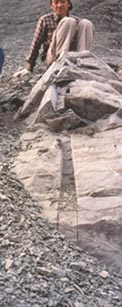Geotimes

News
Notes
Extinctions
More end-Permian
impact proof
 Oceans today
teem with a countless number of species. But this number is only a fraction
of what existed in the Permian, when Earth's oceans had reached their height
of diversity. In the late Permian, about 251 million years ago, something happened
that extinguished over 90 percent of all marine species and 70 percent of terrestrial
vertebrates.
Oceans today
teem with a countless number of species. But this number is only a fraction
of what existed in the Permian, when Earth's oceans had reached their height
of diversity. In the late Permian, about 251 million years ago, something happened
that extinguished over 90 percent of all marine species and 70 percent of terrestrial
vertebrates.
"Understanding the cause of the end-Permian extinction is important because
it represents the largest mass extinction and led to the subsequent origination
of recent biota on Earth," says paleontologist Kunio Kaiho of Tohoku University,
Japan. While the end-Permian death toll far exceeds that of any other extinction,
it is possibly the least understood of Earth's five mass extinction events.
Scientists have suspected for nearly a decade that a meteor impact caused
the extinction at the K/T boundary that killed the dinosaurs. Most believed
the end-Permian extinction an era earlier was due to gradual changes: sea level
drops, volcanism, ocean anoxia or climate change.
[Paleontologist Kunio Kaiho sits at the
end-Permian event boundary of the Meishan A section in southern China. This
boundary could mark where an extraterrestrial impact set the the end-Permian
mass extinction in motion. Courtesy of K. Kaiho.]
Recently, fossil and chemical evidence has provided a different picture, pointing
to an abrupt rather than prolonged end to the Permian and bolstering the theory
that an impact was the cause.
Early this year, Luann Becker at the University of Hawaii suggested that an
extraterrestrial impact slammed into the late Permian Earth and led to mass
extinction. Last year, her team reported that soccer-ball-shaped carbon molecules
called fullerenes, or "buckyballs," held gases with an isotope signature
found only in space (Geotimes, April 2000). In the Feb. 23 Science this year,
her team reported that a comet or asteroid may have brought fullerenes to Earth.
Now geologists may have found further support for the impact theory. In the
September Geology, Kaiho's team reports evidence found in late-Permian sediments
of southern China: rapid declines in marine fossils and other proxies for biomass
(such as phosphorous and calcium), accompanied by nickel-rich layers containing
impact-metamorphosed grains of iron-silicon-nickel composition. The absence
of a large continental impact crater and lack of shocked quartz, a mineral in
continental crust that becomes riddled with fractures during impacts, imply
that the collision took place in the ocean.
The culpable extraterrestial body was either an asteroid 30 to 60 kilometers
wide or a comet 15 to 30 kilometers wide, Kaiho estimates. The K/T meteor was
only 10 kilometers.
The impact triggered a series of cataclysms, Kaiho says. He and his colleagues
discovered an enrichment of the lightweight isotopes of sulfur and strontium
in sediments, indicating that an enormous cloud of sulfur was released from
splattered crust and mantle material, which vaporized from the extreme heat
of impact. The injection of sulfur to the atmosphere caused acid rain. As reduced
forms of sulfur oxidized, oxygen levels in the ocean and atmosphere plummeted
by as much as 40 percent. The impact may have even set off large-scale volcanism
that caused the coincidental Siberian flood basalt event, a lava outpouring
that left a basalt covering larger than Europe.
"I think the work is very exciting and demonstrates that there are several
lines of evidence for some sort of extraterrestrial event, such as an impact,
that triggered this very severe extinction event," Becker says. Other end-Permian
researchers are not so sure. "As the authors themselves note, the nickel
enrichment is only a possible proxy for extraterrestrial impact," says
Douglas Erwin, a research paleobiologist at the National Museum of Natural History.
"Until similar patterns are found elsewhere, it is far too early to characterize
[Kaiho's data] as evidence of impact."
"We are trying to find impact evidence and negative isotope ratios in other
areas in Europe and China, and different depositional environments," Kaiho
says. These studies would clarify whether the isotopic excursion is global or
local and may strengthen the impact theory, he adds.
If the impact theory is proven, "It will raise the question of whether
all such severe extinction events in the record are also linked to large impact
events," Becker says.
Neeta Bijoor, contributing writer
 Oceans today
teem with a countless number of species. But this number is only a fraction
of what existed in the Permian, when Earth's oceans had reached their height
of diversity. In the late Permian, about 251 million years ago, something happened
that extinguished over 90 percent of all marine species and 70 percent of terrestrial
vertebrates.
Oceans today
teem with a countless number of species. But this number is only a fraction
of what existed in the Permian, when Earth's oceans had reached their height
of diversity. In the late Permian, about 251 million years ago, something happened
that extinguished over 90 percent of all marine species and 70 percent of terrestrial
vertebrates.
